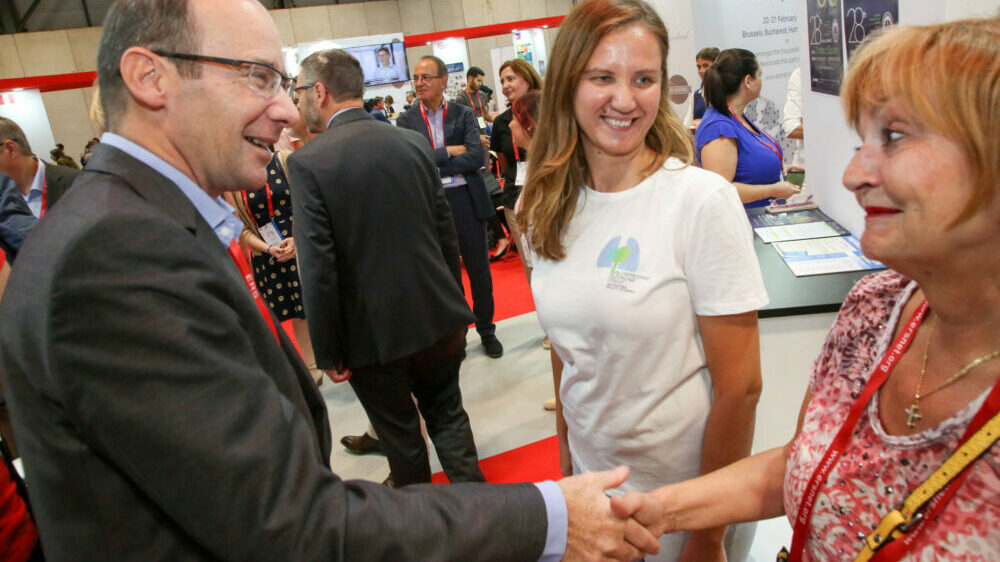“The pandemic is a reminder of the intimate and delicate relationship between people and planet. Any efforts to make our world safer are doomed to fail unless they address the critical interface between people and pathogens, and the existential threat of climate change, that is making our Earth less habitable.”
— World Health Organization (WHO) Director General, Dr Tedros Adhanom Ghebreyesus, Address to the 73rd World Health Assembly, 18 May, 2020.
The American Thoracic Society (ATS), European Respiratory Society (ERS) and International Society for Environmental Epidemiology (ISEE) are dedicated to improving health around the globe, with ATS and ERS achieving this goal by advancing research, patient care and public health in pulmonary diseases, while ISEE advances research on environment and health. The COVID-19 pandemic of 2020 has presented unprecedented challenges on multiple fronts. Like the climate emergency, the COVID-19 pandemic is an existential threat.
This novel zoonotic disease, like others in the past, emerged from a shrinking wildlife habitat. Unlike many other zoonoses, COVID-19 hitched a ride on our globalized and highly mobile society to rapidly devastate populations worldwide (1). The virus has exposed the massive disparities in social determinants of health faced by most of the world’s population, including poor access to health care and structural inequalities that promote unhealthy living (2). Minority status and economic inequality are plainly visible in the pandemic epidemiology, serving as a pressing call to action.
This crisis offers a global opportunity to leap forward instead of slipping back into unsustainable and unhealthy ways of the past. A robust systemic response to the pandemic recovery can better equip us to face the climate emergency that threatens the health of people of all ages across the globe. Society has demanded, and received, extraordinary courage and stamina from frontline providers, including those providing food and other critical services, families and healthcare professionals risking their lives to care for the sick and vulnerable and every person who has stepped forward to help those in need during this unprecedented public health crisis. We have come together in neighborhood support groups, online and physically distanced gatherings.
For the sake of health, we have made tremendous economic sacrifices. Recovery from the pandemic will be difficult and costly, but it is also an opportunity to re-think spending priorities and make decisions that will improve human health and well-being for generations. In this letter we voice our support for the WHO Manifesto for a healthy recovery from COVID-19 and, using an example from the European Commission, outline major opportunities to improve global health and ensure a sustainable future as we move ahead beyond COVID-19.
The WHO Manifesto has six major points, all of which align with the missions of ATS, ERS and ISEE. Herein we adapt these recommendations to the missions of our societies: 1) protect and preserve nature and biodiversity as a source of human health, and protection against spillover events like COVID-19 that emerge from a shrinking animal habitat (3,4); 2) invest in essential services, including clean water and sanitation in communities and healthcare facilities, to reduce risk of infectious diseases (5); 3) transition to clean and renewable energy to reduce air pollution and mitigate climate change (6-10); 4) promote healthy, nutritious and sustainable diets, which, among other health benefits, will reduce risk of diabetes and obesity (11-13); 5) build healthy, liveable communities that promote active mobility and increase social capital and equity (14-15) and 6) Stop using taxpayer money to fund unhealthy air pollution and climate damaging emissions (16-17).
As professional societies dedicated to promoting respiratory and environmental health, we emphasize the need for a clean energy transition and sustainable urban planning to improve air quality, equity and health worldwide.
Clean Energy and Sustainable Urban Planning to Improve Health
When fossil fuels are burned for energy—including the burning of coal and natural gas for electricity and gasoline and diesel for transportation—toxic gases and particles pollute the air, causing illness and premature death. At the same time, carbon dioxide and other greenhouse gases are released into the atmosphere, causing climate change. While air quality regulations have contributed to a decline in air pollution in Europe and the United States, air pollution remains a major health and environmental concern, with substantial adverse effects even at levels below current standards. Air pollution is the fifth highestranking global risk factor for mortality after dietary risks, high blood pressure, tobacco and high fasting plasma glucose, ranking higher than body mass index (ranked 6th), alcohol use (ranked 9th), or low physical activity (ranked 12th) (18), contributing to more than 4.2 million premature deaths globally in 2015. (19). Air pollution has major effects in the context of the current pandemic. Recently emerging evidence from around the world, including the United States, Europe and China, suggests that exposure to air pollution worsens the severity of COVID-19 health outcomes (20,21). Long-term exposure to air pollution increases the risk of respiratory and cardiometabolic diseases, lung cancer, and respiratory infections, which in turn increase the risk of death from COVID-19. Thus, it has been hypothesized that air pollution may increase susceptibility to mortality and morbidity from COVID-19 (22-23). These findings for COVID-19 and other pneumonias are consistent with a robust body of mechanistic and epidemiologic research on respiratory infections, including influenza and SARS (a coronavirus) that have found that air pollution exposure weakens immune defenses and worsens the consequences of infection (24-25).
This updated evidence on COVID-19 points to the need for improved air quality standards and a transition away from polluting fossil fuels. Thus, funding and policies for economic recovery from the pandemic need to include new regulations and incentives to reduce air pollution. Strategies that focus on both average air pollution levels and ‘hot spots’ of air pollution will help to decrease current inequalities faced by people of low socioeconomic status, ethnic minorities, migrants and refugees, all of whom are often exposed to high levels of pollution (26).
Climate change is an existential crisis that has serious effects on pulmonary health and contributes to severe health disparities on a global and local scale (27). Rising global temperatures directly influence respiratory health through extreme weather events, wildfires, prolonged allergy seasons and worsening air pollution (28). Climate change also causes droughts, malnutrition, poverty, and spread of infectious diseases, which all impact health. People living in low resource communities, children, the elderly, and people with underlying lung disease are at elevated risk of complications from the effects of climate change. A healthy post-COVID-19 recovery must address social and health equity as a central goal. COVID-19 has been a painful reminder of marked racial and ethnic disparities in health, as communities of color in the US and Europe have suffered and died from COVID-19 at a disproportionate rate (29). With the ATS/ERS Policy Statement on Disparities in Respiratory Health (30) as a guide, local and national strategies should ensure that populations already at a health disadvantage are privileged in the transition to clean energy and healthy, sustainable urban living.
Addressing climate change has been called the “greatest public health opportunity of the 21st Century.“ (31) COVID-19 has brought these societal vulnerabilities to respiratory disease into sharp focus. The clean air aftermath from forced reductions in transportation and other emissions during the pandemic demonstrates that aggressive and ambitious action can dramatically cut air pollution and carbon emissions. Many options that were previously thought impossible, such as remote work and virtual gatherings, have been successful. On the other hand, the sudden forced reductions in emissions have caused severe economic hardship. Integrated planning will be required to enable sustained emissions reductions while fostering healthy and equitable economic growth.
Policy Strategies Strategies for clean air policies and climate mitigation need to include multiple sectors of society, including energy, industry, transport, and agriculture, and must address levels of consumption by the public. A clean energy transition is urgently needed to solve the climate emergency (32). Switching to renewable energy reduces emissions of greenhouse gases, primarily carbon dioxide and methane, both of which are reversible causes of climate change and carbon pollution. Transportation and mobility need to be transformed to reduce air and noise pollution, greenhouse gas emissions, the squandering of urban space, and sedentary behaviour. Agriculture needs to be changed to be more sustainable, transitioning us towards a majority plant-based diet, with reduced greenhouse gas emissions and air pollution from meat production.
Many cities have recognised these challenges. The COVID-19 pandemic and subsequent lockdowns in many cities showed that carbon dioxide emissions, air pollution and noise levels can be reduced dramatically (> 50%) as a result of reduced traffic and industrial activities (33). Since the lockdown began, we have seen the need to increase public spaces for people to allow physical distancing to reduce the COVID-19 transmission risk. Cities have started to rethink the use of public space and the role of the city in people´s life with moves from car-centric cities to cities for people. Many cities are considerably increasing the kilometres of bike lanes to allow for more sustainable and healthy mobility by bicycle (34).
New urban concepts such as the 15-minute city (Paris), Superblocks (Barcelona) and car-free cities (Hamburg) are being promoted to reduce private car use, carbon dioxide emissions, air pollution, noise, and heat island effects and increase green space and physical activity in cities and thereby improve sustainability, livability and health (35,36). Such measures can also reduce the risk of COVID-19 transmissions and build resilience into our cities for future pandemics. Strong city leadership, citizen participation and multi-sectoral (e.g. urban and transport planning, education, environment and health) and systematic approaches are essential to implement and propagate such changes.
A Policy Example: The European Green Deal
Even without accounting for the health benefits of slowing climate change, the value of the immediate health benefits of clean air actions have been found to outweigh implementation costs by far (37). Leading in the policy arena, the European Green Deal is a comprehensive road map striving to make the EU more resource-efficient and sustainable. It was originally brought forward by the European Commission in 2019 (38). This Green Deal has the overarching aim of reducing sources of carbon dioxide sufficiently to make Europe climate neutral by 2050. It also aims for a zero-emission air pollutant strategy and foresees a revision of the European Air Quality Directive in the current legislative period. The European Green Deal coincides with the United Nations’ Sustainable Development Goals call for major reductions in exposure to air pollution by 2030 (39). The European Green Deal is far from perfect, however. For example, the plan focuses primarily on technologies rather than lifestyle and societal changes that would improve health and equity. Moreover, the financial resources pledged within the Green Deal are too small to achieve the promised goals. It nonetheless represents globally one of the most comprehensive and ambitious climate-neutral and zero-emission air pollution strategies under legislative consideration. Such efforts must be further amplified and multiplied in countries across the globe, including the United States, to limit global warming and improve air quality for the sake of planetary and human health.
Conclusion
The 2020 COVID-19 crisis has shown that people can support unimaginably difficult policies if decision-making is transparent, evidence-based, and inclusive, and has the clear aim of protecting the health of people and their families. Humanity can take advantage of the changes forced by COVID-19 as a reset, adopting and building upon those steps to provide long-term health benefits and protect the planet. By this joint letter from the ATS, ERS and ISEE, we stand with the efforts and those of the WHO to not slip back to ways that contributed to the climate and COVID-19 emergencies we now face, but instead to use policy to leap forward to a healthier future.
References
- https://healthyrecovery.net/https://www.who.int/docs/defaultsource/coronaviruse/situation-reports/20200423-sitrep-94-covid-19.pdf?sfvrsn=b8304bf0_4.
- https://opensafely.org/outputs/2020/05/covid-risk-factors/
- Convention on Biologic Diversity. Biodiversity and Infectious Diseases. https://www.cbd.int/health/infectiousdiseases
- Letko M, Seifert SN, Olival KJ, Plowright RK, Munster VJ. Bat-borne virus diversity, spillover and emergence. Nat Rev Microbiol. 2020;18(8):461-471. doi:10.1038/s41579-020-0394-z https://www.who.int/water_sanitation_health/publications/jmp-2019-full-report.pdf?ua=1
- https://www.epa.gov/clean-air-act-overview/benefits-and-costs-clean-air-act-1990-2020report-documents-and-graphics
- https://www.who.int/news-room/fact-sheets/detail/ambient-(outdoor)-air-quality-andhealth
- https://www.pnas.org/content/116/15/7192.abstract
- https://www.irena.org/costs
- https://www.irena.org/benefits/Job-Creation
- https://www.thelancet.com/journals/lanplh/article/PIIS2542-5196(18)30029-9/fulltext
- https://www.who.int/westernpacific/emergencies/covid-19/information/high-risk-groups
- https://www.who.int/publications/i/item
- https://www.nature.com/articles/s41467-017-00923-8
- https://www.un.org/en/climatechange/cities-pollution.shtml
- https://www.who.int/dietphysicalactivity/factsheet_inactivity/en/
- https://www.iea.org/topics/energy-subsidies
- https://www.imf.org/en/Publications/WP/Issues/2019/05/02/Global-Fossil-Fuel-SubsidiesRemain-Large-An-Update-Based-on-Country-Level-Estimates-46509
- Stanaway JD, Afshin A, Gakidou E, et al. Global, regional, and national comparative risk assessment of 84 behavioural, environmental and occupational, and metabolic risks or clusters of risks for 195 countries and territories, 1990-2017: A systematic analysis for the Global Burden of Disease Stu. Lancet. 2018. doi:10.1016/S0140-6736(18)32225-6
- Cohen AJ, Brauer M, Burnett R, et al. Estimates and 25-year trends of the global burden of disease attributable to ambient air pollution: an analysis of data from the Global Burden of Diseases Study 2015. Lancet (London, England). 2017;389(10082):1907-1918. doi:10.1016/S0140-6736(17)30505-6
- Cole MA, Ozgen C, Strobl E. Air Pollution Exposure and COVID-19. Environmental and Resource Economics, June 2020.
- Zhu Y, Xie J, Huang F, Cao L. Association between short-term exposure to air pollution and COVID-19 infection: Evidence from China. Sci Total Environ. 2020;727:138704. doi:10.1016/j.scitotenv.2020.138704
- Wei Y, Wang Y, Di Q, Choirat C, Wang Y, Koutrakis P, Zanobetti A, Dominici F, Schwartz JD. Short term exposure to fine particulate matter and hospital admission risks and costs in the Medicare population: time stratified, case crossover study. BMJ 2019;367:16258. 10.1136/bmj.l6258.
- MacIntyre EA, Gehring U, Mölter A, Fuertes E, Klümper C, Krämer U Quass U, Hoffman B… Nieuwenhuijsen MJ, Pershegan G, Heinrich J. Air Pollution and Respiratory Infections during Early Childhood: An Analysis of 10 European Birth Cohorts within the ESCAPE Project. EHP 2914;122: 107-113.
- Cui Y, Zhang ZF, Froines J, et al. Air pollution and case fatality of SARS in the People’s Republic of China: an ecologic study. Environ Health. 2003;2(1):15. Published 2003 Nov 20. doi:10.1186/1476-069X-2-15.
- Ciencewicki J, Jaspers I. Air pollution and respiratory viral infection. Inhal Toxicol. 2007;19(14):1135-1146. doi:10.1080/08958370701665434
- Roman J, Viegi G, Schenker M, et al. Research Needs on Respiratory Health in Migrant and Refugee Populations. An Official American Thoracic Society and European Respiratory Society Workshop Report. Ann Am Thorac Soc. 2018;15(11):1247-1255. doi:10.1513/AnnalsATS.201807-478ST
- Bayram H, Bauer A, Abdalati W, Carlsten C, Pinkerton K, Thurston G. Balmes J. Takaro TK. Environment, Global Climate Change, and Cardiopulmonary Health. Am J Respir Crit Care Med. 2017; 195:718-724.
- Rice MB, Thurston GD, Balmes JR, Pinkerton KE. Climate change. A global threat to cardiopulmonary health. Am J Respir Crit Care Med. 2014;189(5):512-519. doi:10.1164/rccm.201310-1924PP
- Thakur N, Lovinsky-Desir S, Bime C, Wisnivesky JP, Celedón JC; Health Equality and Diversity Committee of the American Thoracic Society. The Structural and Social Determinants of the Racial/Ethnic Disparities in the U.S. COVID-19 Pandemic: What’s Our Role? [published online ahead of print, 2020 Jul 17]. Am J Respir Crit Care Med. 2020;10.1164.
- Schraufnagel DE, Blasi F, Kraft M, et al. An official American Thoracic Society/European Respiratory Society policy statement: disparities in respiratory health. Am J Respir Crit Care Med. 2013;188(7):865-871. doi:10.1164/rccm.201308-1509ST
- https://www.thelancet.com/climate-and-health
- Harmer A, Eder B, Gepp S, Leetz A, van de Pas R. WHO should declare climate change a public health emergency. BMJ. 2020; 368: m797.
- Chen K, Wang M, Huang C, Kinney PL Anastasa PT, Air pollution reduction and mortality benefit during the COVID-19 outbreak in China. Lancet Planet Health. 2020 Jun; 4(6): e210- e212. PMID: 32411944
- Weiss 2020. https://www.bloomberg.com/news/articles/2020-07-04/bicycles-are– pushing- aside-cars-on-europe-s-citystreets?cmpid=BBD070620_CITYLAB&utm_medium=email&utm_source=newsletter&utm_ter m=200706&utm_campaign=citylabdaily
- Nieuwenhuijsen MJ. Urban and transport planning pathways to carbon neutral, liveable and healthy cities; A review of the current evidence. Environ Int. 2020 Apr 6:105661.
- O´Sullivan 2020. https://www.bloomberg.com/news/articles/2020-02-18/paris-mayorpledges-a-greener-15-minute-city
- Lim, S. et al. Lancet 380, 2224–2260 (2012).
- European Commission. Communication From The Commission To The European Parliament, The European Council, The Council, The European Economic And Social Committee And The Committee Of The Regions. The European Green Deal. Bussels, 11.12.2019. https://eur-lex.europa.eu/legal-content/EN/TXT/HTML/?uri=CELEX:52019DC0640&from=EN (last accessed July 27, 2020)
- United Nations. Sustainable Development Goals. https://www.un.org/sustainabledevelopment/ (last accessed July 27, 2020)





